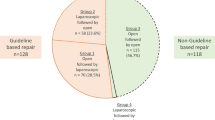Abstract
The American Society of Anaesthesiologists (ASA) 3 and 4 patients are generally considered unsuitable for day case hernia repair. There are minimal data regarding the acceptability of day case repair in these patients. This study analysed day case hernia rates with special emphasis on ASA grades. A retrospective review of all adult inguinal hernia repairs, under the care of one surgeon over a 9-year period, was performed. The data collected included demographics, ASA grades, the mode of anaesthesia and early complications. 577 patients underwent inguinal hernia repair during the study period. 204 (35%) patients were ASA grade 1, 214 (37%) ASA grade 2, 132 (23%) ASA grade 3 and 29 (5%) ASA grade 4. Day case rates for ASA grades 1–4 under LA were 86, 83, 77 and 76% and under GA, 59, 36, 32 and 0%, respectively (P<0.05). There was no significant difference in the wound complication rates for different ASA grades under GA and LA. ASA grades 3 and 4 patients can undergo day case inguinal hernia repair, with similar complication rates to ASA grades 1 and 2 patients, when surgery is performed under local anaesthesia. ASA grades 3 and 4 patients need not be excluded from day case hernia repair.
Similar content being viewed by others
References
Baskerville PA, Jarret PEM (1983) Day case inguinal hernia. Ann R Coll Surg Engl 65:224–225
National institute of clinical excellence (2004) Final appraisal determination, laparoscopic surgery for inguinal hernia repair
The Royal College of Surgeons of England (1993) Clinical guidelines on the management of groin hernias in adults. RCSE, London
National Good Practice Guidance on Preoperative Assessment for Day Surgical Units (2002) Modernisation agency: operating theatre pre-operative assessment programme
Farrow SC, Fowkes FG, Lunn JN, Robertson IB, Samuel P (1982) Epidemiology in anaesthesia 11: factors affecting mortality in hospital. Br J Anaesth 54:811–817
Pedersen T, Eliasen K, Ravnborg M, VIBY-Mogensen J, Qvist J, Johansen SH, Henriksen E (1986) Risk factors, complications and outcome in anaesthesia. A pilot study. Eur J Anaesth 3:225–239
Marx GH, Matteo CV, Orkin LR (1973) Computer analysis of post anaesthetic deaths. Anaesthesiology 39:54–58
Guidelines for Day Case Surgery (1992) The Royal College of Surgeons of England
Day case surgery: operational guide. Waiting, Booking and Choice (2002) Department of Health
Callesen T, Bech K, Kehlet H (2001) One thousand consecutive inguinal hernia repairs under unmonitored anaesthesia. Anaesth Analg 93:1373–1376
Clark SK, Grieve JP, Jarrett PEM (1996) Exclusion from day surgery: a 1-year clinical audit. Br J Surg 83:1383–1384
Warner MA, Shields SE, Chute CG (1993) Major morbidity and mortality within 1 month of ambulatory surgery and anaesthesia. JAMA 270:1437–1442
Chung F, Mozei G, Tong D (1999) Pre-existing medical conditions as predictors of adverse events in day-case surgery. Br J Anaesth 83:262–270
Song D, Grelich NB, White PF, Tongier WK (2000) Recovery profiles and costs of anaesthesia for outpatient unilateral inguinal herniorrhaphy. Anaesth Analg 91:876–881
Gonullu NN, Cubukcu A (2002) Comparison of local and general anesthesia in tension-free (Lichtenstein) hernioplasty: a prospective randomised trial. Hernia 6:29–32
Ozgun H, Nil Kurt M, Kurt I, Cevikel MH (2002) Comparison of local, spinal and general anaesthesia for inguinal herniorrhaphy. Eur J Surg 168:455–459
Merhav H, Rothstein H (1993) A comparison of pulmonary functions and oxygenation following local, spinal and general anaesthesia in patients undergoing inguinal hernia repair. Int Surg 78:257–261
Nordin P, Zetterstrom H, Gunnarsson U, Nilsson E (2003) Local, regional or general anaesthesia in groin hernia repair: multicentre randomised trial. Lancet 362:853–857
Bay-Nielsen M, Kehlet H, Strand L et al (2001) Prospective nationwide quality assessment of 26,304 herniorrhapies in Denmark. Lancet 358:1124–1128
Hair A, Paterson C, Wright D, Baxter JN, O’Dwyer PJ (2001) Diagnosis of a femoral hernia in the elective setting. J R Coll Surg Edinb 46:117–118
Nilsson F, Anderberg B, Bragmark M et al (1993) Hernia surgery in a defined population: improvements possible in outcome and costeffectiveness. Ambul Surg 1:150–153
O’Riordan DC, Kingsnorth AN (1998) Audit of patient outcomes after herniorrhaphy. Surg Clin North Am 78:1129–1139
Kark KE, Kurzer M, Waters KJ (1995) Tension free mesh hernia repair: review of 1098 cases using local anaesthesia in a day unit. Ann R Coll Surg Engl 77:299–304
Saklad M (1941) Grading of patients for surgical procedures. Anesthesiology 2:281–284
Taylor EW, Duffy K, Lee K, King PM, O’Dwyer PJ (2004) Surgical site infection after groin hernia repair. Br J Surg 91:105–111
Putnis S, Merville, Tugg R, Atkinson S (2004) “One stop” inguinal hernia surgery—day case referral, diagnosis and treatment. Ann R Coll Surg Engl 86:425–427
Metzger J, Lutz N, Laidlaw I (2001) Guidelines for inguinal hernia repair in every day practice. Ann R Coll Surg Engl 83:209–214
Ruckley CV (1978) Day care and short stay surgery for hernia. Br J Surg 65:1–4
Kingsnorth A (2003) Management of abdominal hernias, 3rd edn. Arnold, London, p 53
Lichtenstein IL (1987) Hernia repair without disability. Ishiaku Euroamerica, St. Louis, MO
Gianetta E, De Cian F, Cuneo S (1997) Hernia repair in elderly patients. Br J Surg 84:983–985
The MRC Laparoscopic Groin Hernia Trial Group (1999) Laparoscopy versus open repair of groin hernia: a randomised comparison. Lancet 354:185–90
Wellwood J, Sculpher MJ, Stoker D, Nicholls GJ, Geddes C, Whitehead A, Singh R, Spiegelhalter D (1998) Randomised controlled trial of laparoscopic versus open mesh repair for inguinal hernias. Br Med J 317:103–110
Author information
Authors and Affiliations
Corresponding author
Rights and permissions
About this article
Cite this article
Sanjay, P., Jones, P. & Woodward, A. Inguinal hernia repair: are ASA grades 3 and 4 patients suitable for day case hernia repair?. Hernia 10, 299–302 (2006). https://doi.org/10.1007/s10029-005-0048-0
Received:
Accepted:
Published:
Issue Date:
DOI: https://doi.org/10.1007/s10029-005-0048-0




